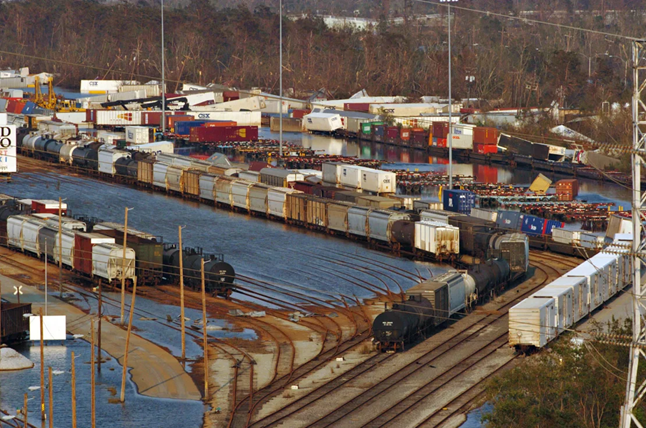Hurricane Awareness for Railcars

Photo Credit: Rail cars are pictured in a flooded railroad yard in New Orleans after Hurricane Katrina in 2005. Daniel Acker/Bloomberg/Getty Images
Shannon Rodgers
Director - Railcar Services
Shannon joined Tealinc in 2019 and brings more than 25 years of rail industry experience to the team. Shannon adds extensive customer-centric expertise to Tealinc with her focus on railcar fleet management, customer support, and railcar data management. At Tealinc, Shannon is responsible for customer on-boarding, customer engagement, fleet management, maintenance planning, and other service responsibilities for all Tealinc owned and managed railcar assets.
After a hiatus of over twenty years, I’m excited to announce my return to the beautiful Sunshine State of Florida. While the sunny weather and proximity to family have been wonderful, I could do without the hurricanes! The recent devastation caused by Hurricane Beryl and Debby reminds us how important it is to evaluate how these intense storms impact your railcar fleet.
In 2017, after Hurricane Harvey hit Texas, we published an article in our September newsletter addressing how hurricanes, saltwater, and high-water impacts railcar fleets. With this year’s hurricane season shaping up to be particularly active, we find it crucial to revisit this information so we’ve revised the 2017 article and included updated rules to ensure you have the newest and best information at your fingertips. We encourage you to share your feedback, questions, and experiences with us as we all navigate these challenges together.
From flooding rains on the plains to hurricanes on the coast, over the years, our team has dealt with railcars affected by flooding. Of top concern have been roller bearings and air brake components which are the primary concerns when high waters impact railcars. Removing mud from every crevice of the cars was always a labor-intensive task. More recently, Hurricane Katrina introduced a new challenge: saltwater. Saltwater is highly corrosive to railcar steel, even to painted surfaces, requiring power washing and treatment with a neutralizing agent to prevent further corrosion.

Here are some relevant AAR Interchange Rules from the Field Manual you should be aware of:
- RULE 95.A.16: The "HANDLING LINE" is responsible for damage from submersion, with specific rules for roller bearings and air brake components.
- RULE 95.A.17: The "HANDLING LINE" is responsible for damage resulting from storms.
- RULE 36.A.1.C: Roller bearings must be replaced if damaged from partial or full submersion.
- RULE 36.E.1: Roller bearings on flood-submerged cars must be reconditioned; cars should not be sent out on their own wheels with a defect card.
- RULE 36.E.2: The "OWNER" is responsible for roller bearing failures not covered by Rule 95. The "HANDLING LINE" must replace submerged bearings before the car moves.
- RULE 4.A.1.c: Submerged air brake valves are condemnable.
- RULE 4.E.14: Submerged valvular components must be replaced. Other submerged air brake components must be cleaned and handled according to Instruction Leaflet No. 2391, Sup. 1.
Finally, RULE 99 (CARS ON PRIVATE AND/OR NON-SUBSCRIBER TRACK) states that if the railcar is submerged on the tracks of a non-railroad, the non-railroad is responsible for cost of repair, for loss or damage to cars in its possession. The handling line is responsible for ensuring that railcars received from a non-subscriber (or other than a railroad subscriber) meets the Mechanical Requirements for Acceptance of the Field Manual of the AAR Interchange Rules, Rule 88. The handling line will also ensure the railcar owner receives a “no charge” billing repair card.
When affected by hurricanes, tropical storms, and flooding waters, here are our recommendations:
- Trace all of your railcars and see if any cars are or were located in the vicinity during the time of a hurricane, tropical storm, or other flooding events.
- If any railcars appear to be stranded at a loading, unloading, or railroad site for an extended period, reach out to the entity in possession of the car to inquire about any potential flood or other damages they may have incurred.
- Ask for digital pictures and a written description of the condition of the car from the party in possession of the car.
- Enlist someone locally who is well versed in AAR rules and railcar repairs to inspect the car and prepare an estimate of the cost of repairs.
- Keep good records of all communications you have with all the relevant parties. You may need them later.
- Even if the railroad assures you that the wheels have been replaced and the air brakes serviced, it's still essential to send the railcar to a trusted contract railcar repair facility for a thorough inspection without delay. Make sure the repair shop conducts steel testing to determine if any salt contamination persists in the car, as specialized test kits are readily available.
- Be prepared for a potentially lengthy and challenging process.
If you find this process overwhelming, Tealinc is here to assist. Our extensive experience in the railroad industry is at your service.
Contact Shannon by email at Shannon@tealinc.com or by phone at (321) 361-9834.








New to rail or need support with your rail business?